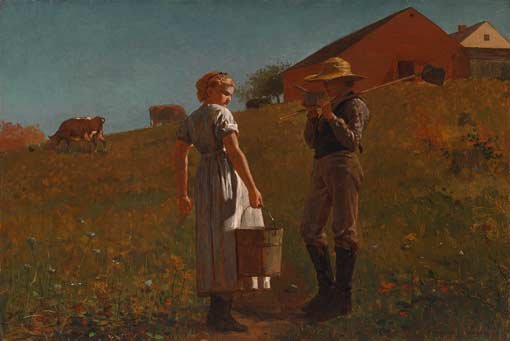Chroniclers of national life

Focus work
Winslow Homer
A temperance meeting 1874
Philadelphia Museum of Art, purchased with the John Howard McFadden Jr Fund, 1956
Within the conventions of genre painting and popular illustration, both of which Winslow Homer had mastered, scenes of rural life could carry a moral message. In the heat of the midday sun, a boy and girl pause in an awkward meeting. Perhaps this is the beginning of a courtship and the transition from childhood to maturity. Sobriety was essential to both, Homer proposed, humorously echoing contemporary temperance campaigns for the erection of drinking fountains.
Following the traumas of the Civil War (1861–65), pastoral images of rural labour and childhood innocence offered comfort and reassurance. Having reported from the front lines of the war for illustrated magazines, Homer afterwards showed a marked preference for scenes of farmers and children playing that he observed at Gloucester, Massachusetts.
Issues for discussion
Describe the emotional tension in this image. How has the artist used compositional and artistic elements to capture this moment? How does the title contribute to the meaning of the work? With reference to this painting, discuss the importance of portraying everyday scenes in this period of American art history.
Artist biography
Winslow Homer is one of America’s most admired artists. The son of a businessman, he was encouraged by his mother, an amateur watercolour painter, to pursue painting and in 1857, after an apprenticeship in lithography, he launched his career as an illustrator. In 1859 Homer moved to New York City where he attended drawing classes at the prestigious National Academy of Design. During the American Civil War (1861–65), he was sent to the front line as an artist-reporter for the illustrated magazine Harper’s Weekly. After the war, Homer began using oils to depict wartime scenes that were admired for their directness and lack of sentimentality; they earned him election to the National Academy of Design at the age of 29. In 1866 Homer spent a year in France, where he was influenced by landscape painters such as Jean-François Millet. Upon his return to New York this influence could be seen through his use of lighter colours and a freer application of paint. Although New York City was his home for over 20 years, Homer spent a great deal of this period travelling to rural, coastal and wilderness sites to observe the outdoor life which he depicted in his work, ranging from fashionable seasonal resorts to rural childhood scenes and African American life in the South. The sea dominates his late work, which ranges from pure seascapes to images of fishermen and shipwreck rescues. Homer built a studio on the Maine coast at Prouts Neck, where he lived as a recluse from 1883 until his death.
More information
Philadelphia Museum of Art website